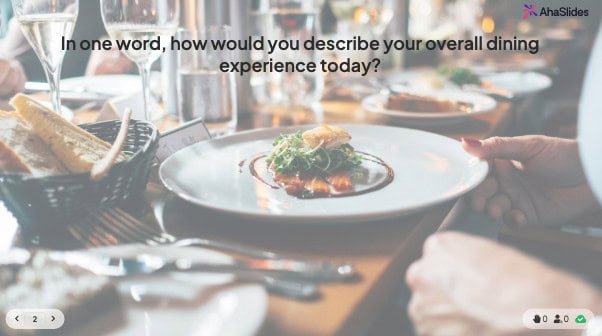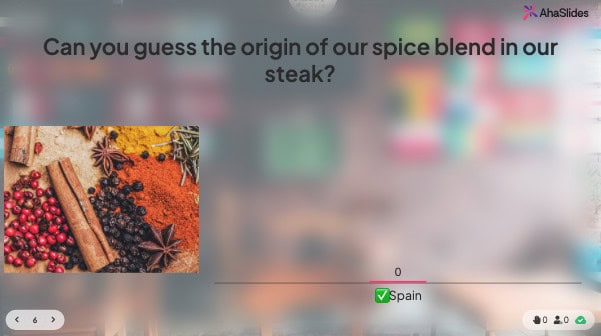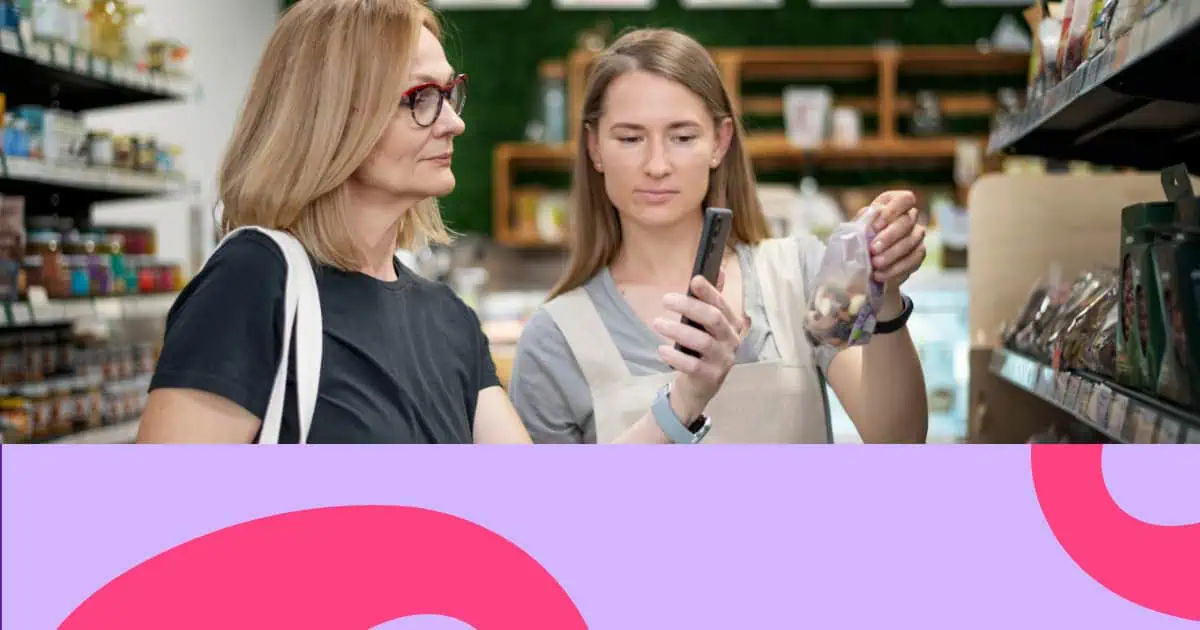Ịnakọta nzaghachi ndị ahịa na ụlọ ọrụ nri & ihe ọṅụṅụ (F&B) dị mkpa karịa mgbe ọ bụla - mana iwepụta azịza ziri ezi na-enweghị imebi ọrụ ka bụ ihe ịma aka. A na-elegharakarị nyocha ọdịnala anya, ndị ọrụ na-arụsi ọrụ ike iji sochie, ndị ahịa anaghị enwekwa mkpali isonye.
Kedu ihe ma ọ bụrụ na enwere ike ijide nzaghachi ndammana, nri mgbe ndị ahịa na-anabatakarị?
Site na AhaSlides, azụmahịa F&B na-anakọta nzaghachi bara uru, ozugbo site na ngosipụta mmekọrịta ewepụtara n'oge oge echere. Chee ya dị ka nzaghachi + akụkọ + ohere maka mmelite - niile site na otu ahụmịhe QR enyi na enyi.
- Ihe kpatara nzaghachi ọdịnala na-ada na F&B
- Gịnị kpatara nzaghachi ka ji dị mkpa na F&B
- Kedu ka AhaSlides si enyere azụmaahịa F&B aka ịnakọta nzaghachi ka mma
- Uru maka ndị ọrụ F&B
- Omume kachasị mma maka nzaghachi F&B na AhaSlides
- Ajụjụ ndebiri a ga-eji ozugbo
- Echiche Ikpeazụ: Nzaghachi kwesịrị ịbụ ngwá ọrụ maka uto-ọ bụghị naanị igbe nlele
- Ntụaka isi maka ịgụ ihe ọzọ
Ihe kpatara nzaghachi ọdịnala na-ada na F&B
Ụlọ oriri na ọṅụṅụ, cafes na ọrụ nri chọrọ nzaghachi-mana usoro ndị a na-emekarị anaghị ewepụta:
- Nnyocha n'ozuzu na-adị ka ọrụ siri ike, karịsịa mgbe e risịrị nri.
- Ndị ọrụ na-enwekarị oge iji kesaa ma ọ bụ soro na nzaghachi n'oge ọrụ n'aka.
- Kaadị nkọwa akwụkwọ na-efunahụ, eleghara anya ma ọ bụ tụfuo ya.
- Enweghị ezigbo ihe kpatara ịzaghachi, ọtụtụ ndị ahịa na-amafe nyocha kpamkpam.
Nsonaazụ: Nghọta efu efu, oke data maka mmelite yana iji nwayọ nwayọ nke ọrụ ma ọ bụ menu.
Gịnị kpatara nzaghachi ka ji dị mkpa na F&B
Ahụmahụ iri nri ọ bụla bụ ohere nzaghachi. Ka ị na-aghọtakwu ihe ndị ahịa gị na-enweta ma na-enwe mmetụta, ka ị ga-emeziwanye onyinye, ọrụ na gburugburu ebe obibi gị.

Nnyocha na-egosi na omume nke ịrịọ nzaghachi na-emetụta mkpa uche miri emi:
- Ndị ahịa na-enwe mmasị ka a jụọ ha echiche ha n'ihi na ọ na-enye ha olu ma na-amụba uru bara uru (mtab.com)
- Ntinye nzaghachi na-ebili mgbe usoro a dị mfe, dị mkpa ma kwe nkwa ime ihe ga-esochi ya (qualaroo.com)
- Ahụmahụ na-adịghị mma na-achụpụ omume nzaghachi siri ike karịa ndị na-anọpụ iche, n'ihi na ndị ahịa na-enwe mmetụta "ọdịiche" nke uche n'etiti atụmanya na eziokwu (mgbochi ebumnuche) (Ụlọ ahịa TouchPoints)
Nke a pụtara: ịnakọta nzaghachi abụghị naanị “mma ịnwe”—ọ bụ akwa n'ime nghọta na imeziwanye ihe kacha dị ndị ahịa gị mkpa.
Kedu ka AhaSlides si enyere azụmaahịa F&B aka ịnakọta nzaghachi ka mma
🎬 Tụgharịa nzaghachi ka ọ bụrụ ihe ngosi mmekọrịta
Kama akwụkwọ ajụjụ kwụ ọtọ, jiri AhaSlides mepụta ihe ngosi na-adọrọ adọrọ, ọtụtụ mgbasa ozi gụnyere:
- Okwu mmalite dị mkpirikpi maka akụkọ ika gị ma ọ bụ ọhụụ ọrụ gị
- Ajụjụ na-enweghị isi ma ọ bụ ngwa ngwa mmekọrịta gbasara ihe menu
- Nyocha ihe ọmụma: "Olee n'ime ndị a pụrụ iche nwa oge anyị n'ọnwa a?"
- Ihe mmịfe nzaghachi: nha ọkwa, ntuli aka, nzaghachi ederede mepere emepe
Usoro imikpu a na-agba ume ikere òkè n'ihi na ọ na-amasị mmetụta mmetụta uche na nke uche, kama inwe mmetụta dị ka ọrụ.
Nweta dị mfe site na koodu QR
Tinye koodu QR na tebụl, menu, nnata ma ọ bụ lelee nchekwa. Mgbe ndị ahịa na-echere ụgwọ ha ma ọ bụ ịtụ ha, ha nwere ike nyochaa ma mekọrịta ihe-ọ dịghị itinye aka na ndị ọrụ.
Nke a na-abanye na akparamaagwa nke ịdị mma: mgbe nzaghachi dị mfe ma wuo ya n'ime mmiri, ọnụego nzaghachi na-akawanye mma. (MoldStud)

Nzaghachi doro anya, a ga-eme ya
Azịza ya na-agara onye nwe/onye njikwa azụmaahịa ozugbo - enweghị ndị etiti ma ọ bụ data agbazere. Nke a na-enyere gị aka ime ngwa ngwa, soro usoro ma gosi ndị ahịa n'ụzọ pụtara ìhè ka etinyere ntinye ha. Mgbe ndị ahịa hụrụ nzaghachi ha na-eduga n'ịgbanwe, ha na-eche na a nụrụ na ọ dị njikere itinye aka na mmekọrịta n'ọdịnihu (mtab.com)
Jiri ebumnobi kpalie isonye
Ị nwere ike ịkwalite mkpali site na ịnye ajụjụ ajụjụ ma ọ bụ ntuli aka na ụgwọ ọrụ: dịka ọmụmaatụ, ihe eji megharịa ọnụ n'efu, mbelata na nleta ọzọ, ịbanye na ihe nrite. Dị ka akparamaagwa omume si kwuo, ndị mmadụ na-enwe mmasị ime ihe mgbe ha na-atụ anya uru ma ọ bụ nnabata (qualaroo.com)
Nke kachasị mkpa, a na-edobe nzaghachi dị ka ihe mgbanwe—ị na-arịọ maka echiche ha n’ihi na i ji ya kpọrọ ihe—na echiche nke uru ahụ n’onwe ya na-abawanye ikere òkè.
Uru maka ndị ọrụ F&B
- Nhazi ngwa ngwa: Sistemu koodu QR ozugbo — enweghị nnyefe dị mgbagwoju anya.
- Ahụmahụ enwere ike ịhazi ya: Hazie ọdịdị na mmetụta gị na akara gị na isiokwu oge.
- Nleba anya oge: Nweta data nzaghachi ka etinyere ya - mee ka nkwalite ngwa ngwa.
- Ibu ndị ọrụ dị ala: Na-emezi usoro nnakọta - ndị ọrụ na-elekwasị anya na ọrụ.
- Ụzọ nkwalite na-aga n'ihu: Jiri loops nzaghachi iji mezie nri, ọrụ, ọmụrụ nwa.
- Ọrụ Abụọ nke Ọzụzụ + Nkwalite: Mgbe ị na-anakọta nzaghachi, ị na-eji aghụghọ kụziere ndị ahịa gbasara ọhụụ ika gị, efere pụrụ iche ma ọ bụ ụkpụrụ gị.
Omume kachasị mma maka nzaghachi F&B na AhaSlides
- Mee ka koodu QR gị ghara ịgbaghara - Debe ya ebe nlebara anya nke ndị ahịa na-agbada: na menus, n'akụkụ tebụl, ihe ọ drinksụ drinksụ, nnata ma ọ bụ nkwakọ ngwaahịa. Ọhụụ na-akpali mmekọrịta.
- Debe ahụmịhe ahụ dị mkpụmkpụ, na-etinye aka na nke onwe gị - Nri maka ihe na-erughị nkeji 5. Nye ndị ahịa aka ịchịkwa pacing ka ọ ghara ịdị ka nrụgide.
- Na-eweghachi ọdịnaya gị mgbe niile - Melite ngosi gị site na iji obere ihe ọhụrụ, ajụjụ nzaghachi, nkwalite oge, ma ọ bụ ebumnuche oge iji mee ka itinye aka dị elu.
- Dakọtara ụda na ikuku ika gị - ntụpọ nkịtị nwere ike iji ihe nkiri egwu na ọchị; ezigbo nri kwesịrị ịdabere n'ime ọmarịcha na aghụghọ. Gbaa mbọ hụ na ahụmịhe nzaghachi dabara na njirimara ika gị.
- Mee na nzaghachi-ma gosi na ị na-eme ya - Jiri nghọta mee ka onyinye gị dị ọcha, wee kwupụta mgbanwe (dịka ọmụmaatụ, "Ị gwara anyị na ị chọrọ nhọrọ veggie mbụ - dị ugbu a!"). Echiche a na-anụ na-abawanye njikere nzaghachi n'ọdịnihu (mtab.com)
Ajụjụ ndebiri a ga-eji ozugbo
Jiri ajụjụ ndị a dị njikere ịga na ngosi AhaSlides gị iji nweta nzaghachi n'eziokwu, kpalite nghọta nwere ike ime ma mee ka ihe ọmụma gị dị omimi banyere ahụmịhe ndị ọbịa:
- "Kedu ka ị ga-esi tụọ ahụmịhe iri nri gị n'ozuzu ya?" (Ọkwa ọkwa)
- "Gịnị kacha amasị gị gbasara nri gị?" (Mepee ederede ma ọ bụ ntuli aka ọtụtụ)
- "Olee efere ọhụrụ ị ga-achọ ịnwale oge ọzọ?" (Ntuli aka ọtụtụ nhọrọ dabere na onyonyo)
- "Ị nwere ike ịma ebe ngwakọta mbinye aka anyị si bịa?" (ajụjụ mkparịta ụka)
- "Gịnị bụ otu ihe anyị nwere ike ime iji mee ka nleta gị ọzọ ka mma?" (Ntụnye emeghere)
- "Kedu ka isiri nụ maka anyị?" (Ọtụtụ nhọrọ: Google, social media, enyi, wdg.)
- "Ị ga-akwado anyị enyi?" (Ee/Ee e ma ọ bụ 1-10 nha nha)
- "Olee otu okwu kacha akọwa ahụmịhe gị na anyị taa?" (Okwu igwe ojii maka itinye aka na anya)
- "Serva gị ọ mere nleta gị pụrụ iche taa? Gwa anyị otu esi eme ya." (Mepere maka nghọta miri emi)
- "Olee n'ime ihe ọhụrụ ndị a ga-amasị gị ịhụ na menu anyị?" (Ntuli aka ọtụtụ nhọrọ dabere na onyonyo)
Echiche Ikpeazụ: Nzaghachi kwesịrị ịbụ ngwá ọrụ maka uto-ọ bụghị naanị igbe nlele
Nzaghachi na ụlọ ọrụ F&B kacha dị irè mgbe ọ dị mfe inye, dị mkpa, na na-eduga ná mgbanwe. Site n'ichepụta mmekọrịta nzaghachi na-asọpụrụ oge ndị ọbịa, kpatụ mkpali ha ịkekọrịta, ma jiri nghọta na-akwalite ezigbo nkwalite, ị na-ewulite ntọala maka uto na-aga n'ihu.
Site na AhaSlides, ị nwere ike gbanwee nzaghachi site na ịtụgharị uche gaa na ịbụ onye na-ahụ maka atụmatụ maka nkwalite.
Ntụaka isi maka ịgụ ihe ọzọ
- Psychology nke nzaghachi ndị ahịa: Gịnị na-eme ka ndị mmadụ na-ekwu okwu? (xebo.ai)
- Otu esi eme ka ndị mmadụ mejupụta nyocha - ndụmọdụ gbasara akparamàgwà mmadụ (qualaroo.com)
- Ihe gbasara akparamaagwa nke ihe mgbu nke ndị ahịa na-atụ: Gịnị kpatara nzaghachi ozugbo dị mkpa (Ụlọ ahịa TouchPoints)
- Psychology n'azụ nzaghachi nzaghachi ndị ahịa (MoldStud)
- Ịtụ nzaghachi ndị ahịa, nzaghachi na afọ ojuju (akwụkwọ agụmakwụkwọ) (Nchoputa.net)





